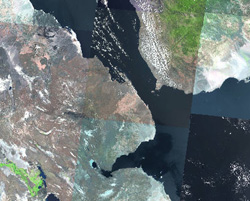
Desert by the Sea
If you walked through the Eritrean Coastal
Desert, chances are good that you'd think you were in a barren landscape
where few species could survive. Sandy or gravelly plains, an occasional
rocky outcrop, and scattered salt-loving grasses and shrubs would be all
you'd view in the landscape around you. But amazingly enough, even this
terrain supports some interesting wildlife species, including gazelles,
sea turtles, and huge numbers of migrating birds of prey.
Special Features
This ecoregion, which stretches along
the coast of Eritrea and Djibouti where they border the Red Sea, lies
along the flyway of one of the largest migrations of raptors in the world.
The climate is hot and dry. An average of less than 4 inches (100 mm)
of rain falls in the region, and average low temperatures are the highest
in Africa--about 80° F (27° C). Sparse grasses and shrubs grow
on most of this flat terrain. Sandy beaches lead to a few sheltered creeks
on the coast, which are fringed with mangrove trees.
Satellite view of the southern Eritrean coast, Djibouti and Yemen -Photograph by USGS